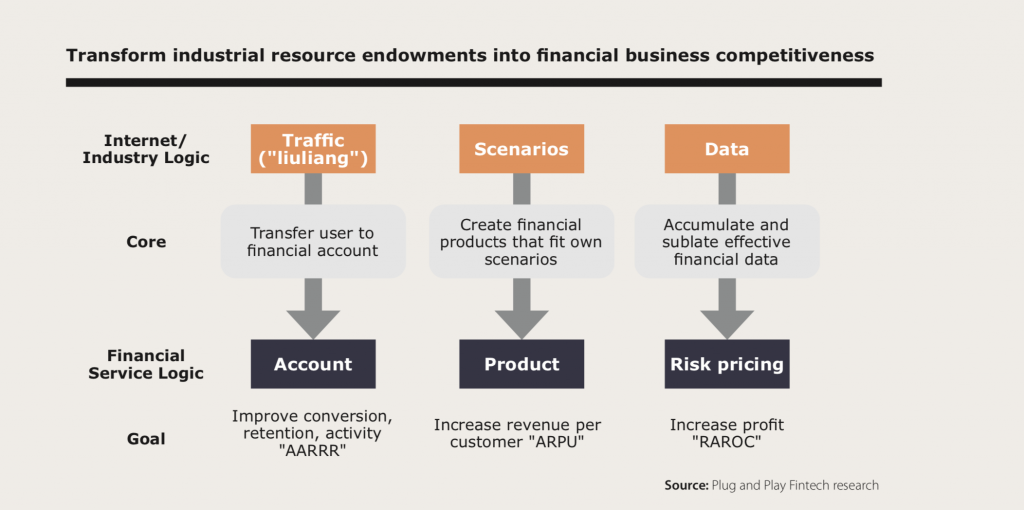Even prior to the pandemic, the global economy had already sustained slow growth and low-interest rates for several years. But COVID-19 aggravated the severity of crises such as regional market risks and geopolitical turbulence. Despite the recent increase of stability across many fronts, we believe that uncertainty will remain the new norm in China’s fintech innovation landscape in the short term.
By Jihuan (Henry) Liang, Jinlong (Eason) Wan, and Linyu Wang
We see three macro trends. First, on the industrial level, the growth rate of the financial industry has slowed down. McKinsey’s Global Banking Report released in early 2020 claims that we are in the late cycle as Fidelity Investments had suggested before. The data in the report shows that the global lending growth rate has lagged behind the GDP growth rate. The growth rate of the banking industry over the past decade has been slower than prior to the global financial crisis.
Second, on the corporate level, competition amongst service providers in the financial industry has become increasingly fierce. In the context of tighter regulation and limited increments on business, competition has shifted from traditional institutional channels to being centered on user experience, product adaptation, operational efficiency or risk control levels. The competitive strategy has been inclined to asset quality and efficiency-oriented rather than to AUM-oriented. Meanwhile, enabling access to foreign capital has further intensified the competition.
Third, on the customer level, the evolving user behavior for financial services has called for a higher demand for convenience, intelligence, humanity and privacy. Due to increasing uncertainty under the current pandemic, the financial industry is in urgent need of digital transformation. The uncertainty has created unprecedented opportunities for digitalization accross the world, and the financial industry continues to explore openings to embrace technology and uncover new areas of growth.
Fintech investments and funding trends in China
From a Fintech investment perspective, Fintech has entered a “cooling-off period” in China. Funding has been declining for two consecutive years, but it went up a little in the second half of 2020. Speaking of funding rounds, the number of IPOs has declined slightly compared to previous years. Early to growth stage startups have got more attention from investors. In terms of focus areas, Chinese VCs mainly focus on enterprise services, asset/wealth management and inclusive finance.
Last year, our observation from the innovation heat map (a Plug and Play methodology to map the startup distribution between technology category and application scenes) concludes that privacy computing would grow rapidly. This year, Chinese authorities issued policies to vigorously promote the data factor and establish a comprehensive data protection mechanism. Therefore, privacy computing technologies such as MPC and federated learning have commenced small-scale deployment.
Based on the latest trends of Fintech investment, in terms of asset side and capital side, there are three key focus areas:
- Wealth management on the capital side. Under the stimulus of a series of policies such as new regulations on asset management, there will be opportunities for re-allocation of individual assets at a level of tens of billions in the future.
- Enterprise services. One of the biggest Fintech trends in the US in 2020 was SaaS+ Fintech. Financial services can enhance customer loyalty, grow more revenues, and increase utilization rate for SaaS companies, while by partnering with SaaS companies, banks have extended access to users and data.
- Industrial Internet. With the development of China’s “New Infrastructure Construction” strategy, traditional industries are all undergoing digitalization. The industrial internet will also become more segmented, intelligent, and personalized, and financial institutions can benefit from this evolution, approach new assets, and transform these assets into data and credits.
Fintech continues to penetrate traditional financial institutions
Fintech companies have gradually penetrated all aspects of financial services by improving the capabilities of front to back offices. Meanwhile, banks are more aware of the penetration of financial technology. In their latest business strategy discussions, you will notice increasing use of Fintech or related keywords. More and more commercial banks are positioning Fintech as the “key driver” for business transformation. State-owned banks, joint-stock banks, and other small and medium banks are all applying financial technologies to digital transformation. The 2020 Research Report on Financial Technology Development of Small and Medium Banks shows that Fintech is deemed as the “coup de grace” for many small and medium banks in their transformation. Over 70 percent of banks have set up a Fintech division as a first-level department. According to our research on their Fintech strategies, combined with current digital transformation trends, we observed the following footprints in terms of Fintech innovation:
1. Be Online, be intelligent, and be open
- Convert more traditional services from offline to online. Build an omnichannel strategy by tapping into emerging channels (WeChat, Alipay, etc.)
- Apply AI applications to online business with matching needs from both retail and corporate customers
- Open banking capabilities (APIs, accounts, platforms, services) to create more data streams and use cases to strengthen client relations
2. Introduce new technologies and applications to improve operational efficiency with emphasis on data factor
- Focus on the introduction of smart operations, smart risk management, and smart CRM with the integration of low-code SaaS applications
- Deploy blockchain applications to build and expand a trusted financial service environment, piloting applications such as traceability, authentic right, trusted execution environment, and multi-stakeholder transactions
3. Develop more non-standard services, shifting from retail banking to corporate banking and establishing use cases for financial services
- Corporate banking products with a lower level of standardization draw more attention than retail banking products with a higher level of standardization
- Streamline corporate banking, implement industry platforms, break down data silos, and set up risk transmission mechanisms
- Explore new business models, engage the long-tail customer group in addition to the core enterprise clients, and reduce information asymmetry between the capital end and the asset end
4. Input and output “Banking-as-a-Service” digital solutions, integrating Industrial Internet
- Focus on several core industries, deep dive into specific business scenarios, and connect financial services to the chain of transaction-account-data.
- Work with partners outside the banking industry to empower them and enable a win-win situation
- Help traditional industry clients with digital transformation to generate new service opportunities because Chinese banks normally have better technological capabilities than their traditional clients
Fintech helps to find new markets for business growth
Following the target of China’s 14th Five-Year Plan on the development of new infrastructure construction since 2020, traditional industries are undergoing digital transformation rising upon the methodology of the industrial Internet. Enterprises of all sizes must pursue development through collaboration with each other, and more attention should be given to SMEs to address their challenges in accessing capital. With the urgent need for digital transformation, the corporate finance field nurtures innovation opportunities. Compared to the revolution of the mobile Internet which emphasizes the consumer end, the revolution of the industrial Internet asks for in-depth knowledge of value chains and first-hand industry Know-Hows from the supply side. It is truly challenging for a single platform to serve all parts of multiple industrial chains.
Though Payment tools are where Fintech firstly added tremendous value, the emerging To B solutions like payroll/benefits/tax/B2B platform/account management have integrated with fintech to extend the scope of customer services and enable collaboration amongst businesses of all sizes with the help of real data. While financial institutions provide services to industries, they also gain insights that capture new customers and increase loyalty.

Based on specific use cases and feature sets, financial services are capable of building new product and service models by setting up corporate accounts, connecting risk management and customer profiles. At the same time, IT connectivity enables banking services to strengthen customer stickiness, thus incubating new business models.
In Plug and Play China’s Fintech Acceleration Programs, we have consistently seen innovative business models. Here are three examples:
1. Innovation in enterprise service
By building its own corporate wallet, a company can calculate the costs of NPM (non-productive material) in real time. The corporate wallet alleviates problems of employee reimbursement. Also, it enables management to understand the company’s expenditures in time and provides evidence to optimize the company’s system and operation process. Moreover, the wallet builds models through corporate’s historical transaction data to grant corporate credit and to unlock new credit scenarios.
2. Innovation in embedding finance
A supply chain financing system for tourism ticketing offers a solution to the shortage of funds of travel agents. Travel agents can use virtual tickets as collateral to get funding, while banks establish their own ticket verification system to monitor the real-time sales and manage credit risk.
3. Innovation in Industrial Internet
A device with an RFID module collects and mines real-time data, enabling the factory owner to monitor the actual condition of the manufacturing process and optimize the product plan. Such a system can also support banks on risk control and customer acquisition, by providing insights from historical data. With estimates of peak production, time to purchase raw materials and etc., banks are able to market financial services to the manufacturers in advance.
In 2021, we forecast that financial institutions will keep building their moat on the retail banking side and developing niche market in clothing, food, housing, and transportation. On the corporate banking side, they will provide digital solutions for industries that have comprehensive value chains such as healthcare, automotive and education to capture new growth opportunities.
The authors work for the Fintech team at Plug and Play China, an AmCham China Digital Circle company. For more information, please email fintech@pnpchina.com. This article is featured in our Quarterly Magazine. Access the full issue in the Publications tab after logging into our member portal here.

